Support for disposable chroot environments (pbuilder), which can be very
useful for C and C++ projects
# Node Setup
On every node, where you want to run the plugin, you have to
1. install pbuiler:
``` syntaxhighlighter-pre
apt-get install pbuilder
```
2. Allow jenkins to use *pbuilder:*
``` syntaxhighlighter-pre
jenkins_user ALL=(ALL) NOPASSWD: /usr/sbin/pbuilder
```
# Setup a Chroot Environment
## Minimal Setup
Create chroot environments in *Manage Jenkins* \> *Chroot Environments*:
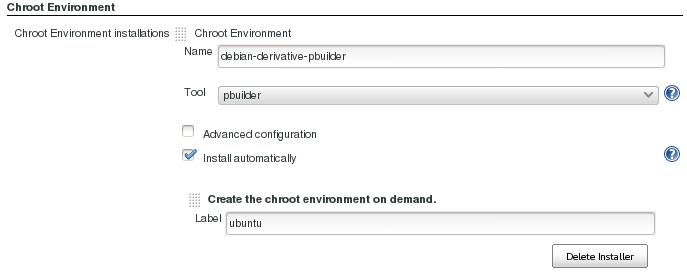
**Make sure that "Install Automatically" is selected, and is configured
to use the "Create the chroot environment on demand" installer!**
## Advanced Setup
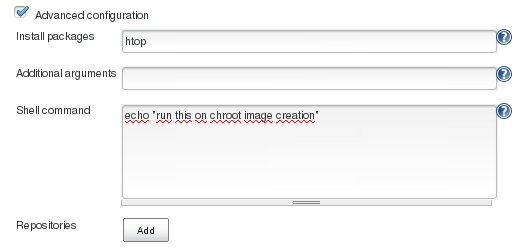
### Adding repositories
You can add **ppa's** and standard repositories like **universe**. The
plugin distinguishes between the two types by the **Repository URL**
prefix. If it starts with *deb*, the repository is just added to
*/etc/apt/sources.list.d/* and the key is imported. If the URL starts
with *ppa*, the repository is added via *add-apt-repository* (no keyfile
is required).
#### Adding the universe repository
**Name**: universe
**Repository URL**: deb <http://archive.ubuntu.com/ubuntu> **DISTRO**
universe
**Keyfile URL**:
<http://archive.ubuntu.com/ubuntu/project/ubuntu-archive-keyring.gpg>
Make sure to select the correct distro of the chroot environment. By
default a chroot environment similar to the host system where the node
is running is created.
In the screenshot at the end of this section i have used **lucid**.
#### Adding ubuntugis ppa
**Name**: ubuntugis
**Repository URL**: ppa:ubuntugis/ubuntugis-unstable
The resulting repositories section should now look like this:
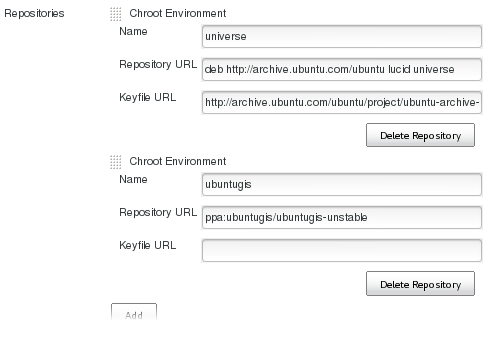
# Using a Chroot Environment
## Minimal Setup
After you have configured a Chroot-Environment, it can be used in the
Chroot Buildstep in every job.
Make sure, that you restrict the job to nodes where pbuilder is
configured.

Add a Chroot Buildstep:
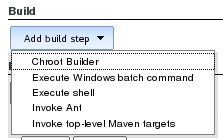
Select the chroot environment and add the build instructions:
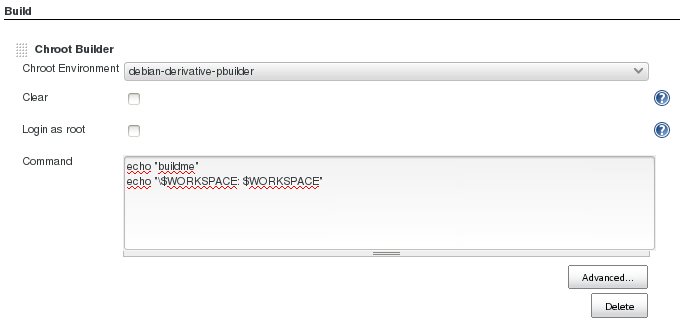
**Chroot Environment**: A list of the predefined chroot environments
**Clear**: The chroot environment (of the job) will be reset to the
state of the predefined environment before every build ( better
reproducability, slower build)
**Login as root**: The build comands will be run via the root unser
inside of the environment (**although it is inside the environment, be
carefull what you do!**)
**Command**: the build commands (uses bash per default)
**Note, that all the jenkins specific environment varaibles are
available!**
## Advanced Configuration

**Requirement Files**: Files which contain package dependencies
(comparable to requirements.txt in the python world)
**Requirements**: Additional package dependencies, not listed in any
requirement file
**Ignore exit code**: The build will always succeed, no mather if the
build step fails or not.
**Do not update repository indices**: speeds up the build, but will not
fetch and install the newest versions of the packages
**Force installation of packages**: allows the installation of unsigned
packages (can be dangerous)
# Run the job
After configuring a new chroot instance it will be built along with the
first job which uses this environment. When launching the build, you
will encounter something like this:

Here the two previously configured repositories (ubuntugis and universe)
are added:
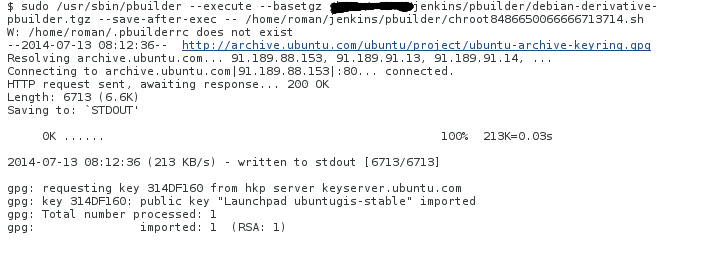
These steps are part of the initial creation of the environment, which
can take a few minutes. They are only excuted once, if you add a
completely new environment, or if you change the existing configuration
in the Jenkins System configuration.
This is what we actually wanted to do in the build (as stated before,
the $WORKSPACE variable was available inside the chroot environment):

# Roadmap
- mock support is next
# Changelog
### Version 0.1.4
- add support for Ubuntu \> 12.04
- better detection if the chroot binary is correctly set up for
Jenkins
- correctly process additional chroot arguments with quotes
### Version 0.1.2
- fixes a null pointer exception when building on a slave node
- uses 'local' copying of chroot image FilePaths, no more network
involved
- removes useless tarBall field from ChrootToolsetProperty
- detects aborted/failed chroot environment initializations
### Version 0.1.1
- adding description and wiki page to pom
### Version 0.1
- initial release
- pbuilder support (mock not usable at the moment)